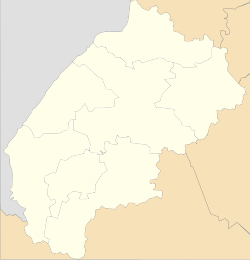Sokal
Sokal
Сокаль | |
|---|---|
City | |
 Townhouses on the square in the city center | |
 | |
| Country | |
| Province | |
| District | Sokal Raion |
| First mentioned | 1377 |
| Population (2013) | |
• Total | 21,386 |
| Time zone | UTC+2 (EET) |
| • Summer (DST) | UTC+3 (EEST) |
Sokal (Template:Lang-uk, translit. Sokal’) is a city located on the banks of the Bug River in Lviv Oblast of western Ukraine. It serves as the administrative center of Sokal Raion (district). Population: 21,386 (2013 est.)[1].
Until 1951 the town was located in Poland, and then transferred to the Soviet Union in the framework of 1951 Polish–Soviet territorial exchange.
History

First written mention of Sokal comes from 1377. In 1424, it received Magdeburg rights from prince of Mazovia Ziemowit, and in 1462, the town became part of Belz Voivodeship, Lesser Poland Province of the Polish Crown. On August 2, 1519, a Polish - Lithuanian army under Hetman Konstanty Ostrogski lost here a battle with Crimean Tatars, after which the town was completely burned by the invaders. Mikolaj Sep-Szarzynski later dedicated one of his poems to this battle.
The town remained in Poland until the first partition of Poland, when it was annexed by the Habsburg Empire, as part of Galicia. It was the capital of the Sokal district, one of the 78 Bezirkshauptmannschaften in Austrian Galicia province (Crown land) in 1900.[2] After World War One, the fate of this province was disputed between Poland and Soviet Russia, until the Peace of Riga in 1921, attributing Eastern Galicia to Poland. In the Second Polish Republic, Sokal was the seat of a county in Lwow Voivodeship.
Sokal lay in Polish territory until the German invasion of Poland in September 1939. From September 1939 until June 1941 (see Operation Barbarossa), it was part of the Soviet territory, who returned here in July 1944. Western part of the town (former village of Zhvirka) remained in Poland between 1944 and 1951 (see 1951 Polish–Soviet territorial exchange). Before the Holocaust, Sokal had a Jewish population of 6,000, of whom only 30 survived. The Soviet army re-captured the town in July 1944.[3]
In the early 17th century, a large Baroque monastery of the Bernardine monks, together with Roman Catholic church of Virgin Mary was built here. The complex is located in the district of Zhvirka, and until World War Two, it housed the painting of Our Lady of Sokal, which attracted Catholic pilgrims. Jan Ostrorog, one of the first Polish humanists was buried here. After the war, the painting was moved to a church in Hrubieszow, while the monastery was turned into a prison. On March 27, 2012, due to negligence of Ukrainian prison authorities, the historic complex almost completely burned.
People
Sokal was the city of the holy Jewish Rabbi Shmuel Rokeach and his son Shulem. Reb Shmuel was buried in Sokal, and his son survived the Second World War.
Omelan Pleszkewycz, co-founder of the Selfreliance Ukrainian American Credit Union in Chicago and president of the World Council of Ukrainian Credit Unions, was born near Sokal and graduated from secondary school there.[4]
Sokal is the birthplace of Polish scholars Mieczyslaw Klimowicz and Czeslaw Hernas, as well as actor Mieczyslaw Swiecicki.
In fiction
Sokal is the location of the opening of the 2009 novel The Kindly Ones by Jonathan Littell, which takes place immediately following the German invasion of Soviet-occupied Poland in June 1941.
Gallery
-
Bernardine Monastery
-
Saint Nicholas church
-
Cathedral of Saints Apostles Peter and Paul
-
Roman Catholic Church
-
Church of Archangel Michael
-
Gymnasium
-
Department of State Treasury in Sokal district
-
City hall of Sokal
-
Tower and walls of Bridgettines convent
References
- ^ Чисельність наявного населення України [Actual population of Ukraine] (in Ukrainian). State Statistics Service of Ukraine. Archived from the original on 2014-02-02. Retrieved 21 January 2015.
- ^ Die postalischen Abstempelungen auf den österreichischen Postwertzeichen-Ausgaben 1867, 1883 und 1890, Wilhelm KLEIN, 1967
- ^ Search of a Shared Past in East Galicia, With Camera in Hand
- ^ Ukrainian Cooperative Movement in Diaspora.': Historical Overview, 1940-1992. Editor-in-chief Omelan Pleshkewych. Chicago, Illinois: World Council of Ukrainian Cooperatives. pp.135-137











